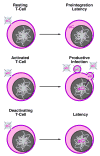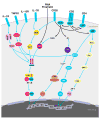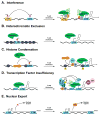Regulation of HIV-1 latency by T-cell activation
- PMID: 17643313
- PMCID: PMC2063506
- DOI: 10.1016/j.cyto.2007.05.017
Regulation of HIV-1 latency by T-cell activation
Abstract
HIV-infected patients harbor approximately 10(5)-10(6) memory CD4 T-cells that contain fully integrated but transcriptionally silent HIV proviruses. While small in number, these latently infected cells form a drug-insensitive reservoir that importantly contributes to the life-long persistence of HIV despite highly effective antiviral therapy. In tissue culture, latent HIV proviruses can be activated when their cellular hosts are exposed to select proinflammatory cytokines or their T-cell receptors are ligated. However, due to a lack of potency and/or dose-limiting toxicity, attempts to purge virus from this latent reservoir in vivo with immune-activating agents, such as anti-CD3 antibodies and IL-2, have failed. A deeper understanding of the molecular underpinnings of HIV latency is clearly required, including determining whether viral latency is actively reinforced by transcriptional repressors, defining which inducible host transcription factors most effectively antagonize latency, and elucidating the role of chromatin in viral latency. Only through such an improved understanding will it be possible to identify combination therapies that might allow complete purging of the latent reservoir and to realize the difficult and elusive goal of complete eradication of HIV in infected patients.
Figures



References
-
- Perelson AS, Essunger P, Cao Y, Vesanen M, Hurley A, Saksela K, et al. Decay characteristics of HIV-1-infected compartments during combination therapy. Nature. 1997;387:188–91. - PubMed
-
- Chun TW, Davey RT, Jr, Ostrowski M, Shawn Justement J, Engel D, Mullins JI, et al. Relationship between pre-existing viral reservoirs and the re-emergence of plasma viremia after discontinuation of highly active anti-retroviral therapy. Nat Med. 2000;6:757–61. - PubMed
-
- Schrager LK, D’Souza MP. Cellular and anatomical reservoirs of HIV-1 in patients receiving potent antiretroviral combination therapy. Jama. 1998;280:67–71. - PubMed
-
- Di Mascio M, Dornadula G, Zhang H, Sullivan J, Xu Y, Kulkosky J, et al. In a subset of subjects on highly active antiretroviral therapy, human immunodeficiency virus type 1 RNA in plasma decays from 50 to <5 copies per milliliter, with a half-life of 6 months. J Virol. 2003;77:2271–5. - PMC - PubMed
Publication types
MeSH terms
Substances
Grants and funding
LinkOut - more resources
Full Text Sources
Other Literature Sources
Medical
Research Materials

